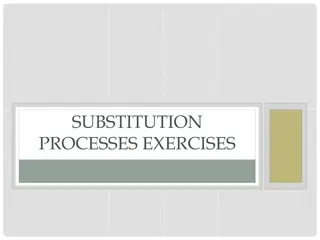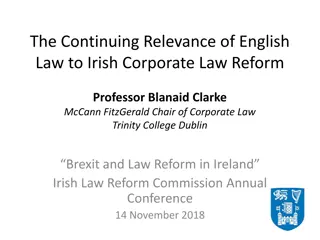Understanding Fronting and Captive Reinsurance in English Law
This material delves into the nuances of fronting and captive reinsurance arrangements under English law, covering topics such as characteristics, duties of fair presentation, notification and claims provisions, and cut-through clauses. It outlines the roles of the original insured, fronting insurer, and reinsurer, exploring various types of captives and the reasons behind these arrangements. The content emphasizes the separate legal nature of the original policy and reinsurance policy, highlighting case examples and commercial relationships in the reinsurance industry.
Download Presentation

Please find below an Image/Link to download the presentation.
The content on the website is provided AS IS for your information and personal use only. It may not be sold, licensed, or shared on other websites without obtaining consent from the author. Download presentation by click this link. If you encounter any issues during the download, it is possible that the publisher has removed the file from their server.
E N D
Presentation Transcript
Fronts and Captives: Reinsurance Law Issues Peter MacDonald Eggers QC 7 King s Bench Walk
Topics Characteristics of fronting and captive reinsurances Duty of fair presentation of the risk Notification and claims provisions Cut-through Clauses NOTE: Assume English law applies, but that will often not be the case in respect of all contracts 2
Characteristics Original Insured Fronting Insurer Reinsurer The Fronting Insurer may or may not be a captive The Reinsurer may or may not be a captive Types of captive: Owned Captive Distinguish mutual insurance Non-affiliated Captive The reasons for these arrangements may relate to financial advantages (pricing, cash flow, tax), obtaining more extensive coverage, exercising greater control or managing regulatory restrictions 3
Characteristics The policies are not often labelled as fronting arrangements All or most of the risk insured under the Original Policy is ceded to the Reinsurer All or most of the premium payable under the Original Policy is payable to the Reinsurer The sum retained by the Front/Captive may be called a premium, a commission, or a fee The use of security or collateral to protect against credit risks 4
Characteristics The Original Policy and the Reinsurance Policy are separate contracts This is a legally valid arrangement (subject to regulatory requirements) That means the Fronting Insurer bears a liability to the Original Insured and the Reinsurer bears a liability to the Fronting Insurer Prifti v Musini Sociedad Anonima (No. 2) [2006] Lloyd s Rep IR 221 5
Characteristics The commercial relationship may be between the Original Insured and Reinsurer Randgold Resources Ltd v Santam Ltd [2019] Lloyd's Rep IR 467 Axis Corporate Capital v ABSA Group [2021] EWHC 861 (Comm) Note the use of insurance or reinsurance pools Where reinsurance of fronting insurer of pool was for benefit of all pool members North Atlantic Insurance Co Ltd v Nationwide General Insurance Co [2004] Lloyd s Rep IR 466 Cf. R&Q Insurance (Malta) Ltd v Continental Insurance Co [2017] EWHC 3666 (Comm) 6
Characteristics Absent any express contractual arrangements, the Reinsurer is not liable to the Original Insured There may be a simultaneous Payments Clause The Reinsurer might be liable to the Original Insured under a Cut-Through clause The Reinsurer will usually exercise a measure of claims control under the Original Policy 7
Characteristics The Reinsurance will usually incorporate the terms of the Original Policy CNA International Reinsurance Co v Companhia de Seguros Tranquilidade SA [1999] Lloyd s Rep IR 289 Cf. WASA International Insurance Co v Lexington Insurance Co [2008] Lloyd s Rep IR 510 (CA): Longmore, LJ It might be suggested that, even if the insurance contracts should bear the same meaning, that same meaning should be the English [Reinsurance] rather than the Pennsylvania [Original Policy] meaning. It might indeed be possible to imagine a case where the insurance was put together in London and the interposition of a front or a captive local insurer might be in truth something of a formality in which the tail of the front or captive insurer should not be allowed to wag the reinsurance dog . The Reinsurance may have its own express provisions: Amlin Corporate Member Ltd v Oriental Assurance [2014] 2 Lloyd s Rep 561 8
Fair presentation of the risk The duty of fair presentation now set out in sect. 3-8 of the Insurance Act 2015 Applicable to reinsurance and retrocession contracts: Explanatory Notes, para. 36 In the ordinary course, the Original Insured may possess much of the actual knowledge of the risk The Fronting Insurer may not possess much information 9
Fair presentation of the risk Focus on the Reinsurer as the person who requires the material underwriting information In some cases, information is passed from the Original Insured through the Fronting Insurer to the Reinsurer (often through brokers) In some cases, there will be direct discussions between the Original Insured and the Reinsurer (sometimes even before the Fronting Insurer is identified) The Fronting Insurer may not be able to rely on any relative ignorance in discharging its duty of disclosure to the Reinsurer 10
Fair presentation of the risk If the Original Insured or its broker negotiates directly with the Reinsurer, its knowledge may be attributed to the Fronting Insurer pursuant to sect. 4(3)(b) of the Insurance Act 2015 Sect. 4(8)(b): an individual is responsible for the insured s insurance if the individual participates on behalf of the insured in the process of procuring the insured s insurance (whether the individual does so as the insured s employee or agent, as an employee of the insured s agent or in any other capacity) Note sect. 4(5)(b) and confidential information Confidential information obtained by a person responsible for the insurance as the insured s agent from a person connected with the reinsured contract might be taken to be known by the Fronting Insurer 11
Fair presentation of the risk If the Original Insured makes a direct representation to the Reinsurer and the Fronting Insurer is not present, the subsequent entry into the Reinsurance may result in the Fronting Insurer adopting the Original Insured s representation The Zephyr [1984] 1 Lloyd s Rep 58; [1985] 2 Lloyd s Rep 529 Bonner v Cox Dedicated Corporate Member Ltd [2005] Lloyd s Rep IR 569 Briess v Woolley [1954] AC 333 (non-insurance) 12
Fair presentation of the risk If there is no contact between the Original Insured and the Reinsurer, the Fronting Insurer may have constructive knowledge of what the Original Insured knows which the Fronting Insurer may have to disclose pursuant to sect. 3(4) of the 2015 Act Sect. 4(6)-(7) of the 2015 Act: The Fronting Insurer ought to know what should reasonably have been revealed by a reasonable search of information available to the Fronting Insurer (whether the search is conducted by making enquiries or by any other means), including information held within the Fronting Insurer s organisation or by any other person. 13
Fair presentation of the risk If the Original Insured makes a representation to the Fronting Insurer who passes it on to the Reinsurer, the Fronting Insurer will be treated as having made that representation to the Reinsurer: Highlands Insurance Co v Continental Insurance Co [1987] 1 Lloyd s Rep 109 Sirius International Insurance Corp v Oriental International Assurance Corp [1999] 1 All ER (Comm) 699 14
Fair presentation of the risk Where information has been provided to the Fronting Insurer, it may have to disclose that information to the Reinsurer: China Traders Insurance Company Limited v Royal Exchange Assurance Corporation [1898] 2 QB 187 London General Insurance Company v General Marine Underwriters Association [1920] 3 KB 23; [1921] 1 KB 104 However, if the Fronting Insurer does not pass it on to the Reinsurer, although it might be under a duty to disclose information, it will not be treated as having made a misrepresentation: Feasey v Sun Life Assurance Co of Canada[2002] Lloyd s Rep IR 807 15
Claims and notification provisions Claims provisions include: Notification of loss, claims or circumstances Provision of information or assistance Requirements not to admit liability Control of defence and investigation of claim Requirement of consent to settlement The provision may permit the Insurer/Reinsurer to control the claim or the Insured/Reinsured to co- operate 16
Claims and notification provisions The Reinsurance may incorporate the Claims Control or Handling provisions of the Original Policy, subject to language manipulation This may not result incorporation of notification provisions CNA International Reinsurance Co v Companhia de Seguros Tranquilidade SA [1999] Lloyd s Rep IR 289 this was essentially a fronting arrangement in which the terms of the reinsurance were agreed first including the reinsuring terms set out in the standard wordings, which are in my judgment adaptable for this purpose even though they were originally drafted in the context of insurance and not reinsurance. It makes sense for both Tranquilidade and the original insured to be bound by the same terms. For example one would expect to see both reinsuring words and claims procedure clauses in the form referred to in the slip given the lack of experience of Tranquilidade in matters of this kind and given the fact that the reinsurers were taking 90 per cent of the risk, Mr Hine would have expected the reinsurers to have control of any claim on the underlying insurance. Cf. Municipal Mutual Insurance Ltd v Sea Insurance Co Ltd [1996] 1 Lloyd s Rep 265 (Waller, J) 17
Claims and notification provisions The Reinsurance will often impose its own Claims Control or Co-operation provisions Grecoair Inc v Tilling [2005] Lloyd's Rep IR 151 Lexington Insurance Co v Multinacional de Seguros SA [2009] Lloyd s Rep IR 1 Where retrocessions from fronting reinsurances contained follow the settlements or follow the fortunes clauses: Assicurazioni Generali SpA v CGU International Insurance [2003] Lloyd s Rep IR 725; [2004] Lloyd s Rep IR 457 English and American Insurance Co Ltd v AXA Re SA [2007] Lloyd s Rep IR 359 18
Claims and notification provisions The Reinsurance may contain its own notification provisions: Royal and Sun Alliance Insurance plc v Dornoch Ltd [2004] Lloyd's Rep IR 826 AIG Europe (Ireland) Ltd v Faraday Capital Ltd [2008] Lloyd's Rep IR 454 Could the Original Insured give notice direct to the Reinsurer? CNA International Reinsurance Co v Companhia de Seguros Tranquilidade SA [1999] Lloyd s Rep IR 289 Barratt Bros (Taxis) Ltd v Davies [1996] 1 WLR 1334 19
Cut-through clauses A cut-through clause in the Reinsurance Contract stipulates that the Original Insured may claim an indemnity directly from the Reinsurer This may be unqualified or may be limited to particular circumstances, such as insolvent events It presupposes that there is liability under both the Original Policy and the Reinsurance In the event of the Fronting Insurer s insolvency, such provisions may be invalid, at least insofar as the Original Insured is a third party to the Reinsurance: Mance, Insolvency at Sea [1995] LMCLQ 34 Cf. Folgate London Market Ltd v Chaucer Insurance plc[2011] Lloyd s Rep IR 623 20
Cut-through Clauses The Original Insured may be a party to the Reinsurance Contract and therefore has a directly enforceable right to demand an indemnity from the Reinsurer Axis Corporate Capital v ABSA Group [2021] EWHC 861 (Comm) The Original Insured may not be a party to the Reinsurance Contract There is no privity of contract Grecoair Inc v Tilling [2005] Lloyd's Rep IR 151 In that event, its right to enforce the indemnity against the Reinsurer depends on Contracts (Rights of Third Parties) Act 1999 Randgold Resources Ltd v Santam Ltd [2019] Lloyd's Rep IR 467 Unless there is a 1999 Act exclusion clause 21
Peter MacDonald Eggers QC pme@7kbw.co.uk 020 7910 8300























